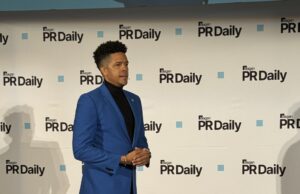How Peloton disarmed critics and hit a PR home run
The exercise bike company was able to score a big hit after being featured in the fictional death of a beloved TV character.

How would you react if your company was unreasonably targeted by critics, and the criticism resulted in stock losses and bad press across the country? If you’re fitness company Peloton, you roll with the punches by:
- Issuing a reassuring statement which highlights value to customers.
- Releasing a high-quality video poking fun at the controversy.
- Bringing in actor and businessman Ryan Reynolds’ star power to get even better press.
Not everyone has connections to nab a Hollywood star or the resources to produce an amazing video on short notice. But PR professionals, business owners, and non-profit leaders can learn from Peloton’s crisis communications judo to take back control of the narrative.
And just like that…
Peloton is an exercise company dealing with serious stress. Their stock is down by 75% as people are replacing home bikes with new gym memberships. The company implemented a hiring freeze, and they’ve instituted massive customer price reductions even as they recalled their treadmill.
Each of these challenges is an obstacle to long-term brand positioning. And then popular “Sex and the City” character John Preston, also known as Mr. Big, died of a heart attack after riding a Peloton bike.
The reaction to a TV character’s death was immediate and astounding. Peloton’s stock dropped by about one-eighth, and “Sex and the City” fans turned the incident into a trending social media topic. Media outlets from Deadline to NBC reported on fans’ reactions to the fake death.
A lot of companies would panic at such an irrational audience reaction, issuing terse statements that would make them look stiff and disconnected. Other companies would ignore the “controversy” entirely, knowing that it’ll blow over. Peloton took a different approach, combining Hollywood actors, a medical expert, a popular Peloton instructor and an expert video team to turn publicity disaster into positive media coverage.
Three steps for disarming critics
Peloton had a three-part response to the unforeseen brand crisis:
1. Issue a statement from cardiologist Suzanne Steinbaum, a medical doctor on the company’s Health & Wellness Advisory Council, which acknowledged fans’ distress, pointed to real health challenges which could cause a heart attack after cycling, and then summarized how to avoid heart attacks with and without a Peloton bike.
2. Declare through a spokesperson that Peloton was unaware of how the bike was going to be used in the show.
3. Release a video titled “He’s Alive” which featured Preston actor Chris Noth and popular Peloton bike instructor Jess King discussing going for a bike ride, with Ryan Reynolds’ voiceover declaring Noth to be alive and well.
By deflecting instead of fighting, and by taking fans’ over-the-top reactions in stride, Peloton won the day. Over 300,000 people watched the ad. Entertainment Weekly, which received the statement from Steinbaum, closed its article with lighthearted gratitude “for Mr. Big’s stationary bike” keeping “him around…to get this one last episode with him.” CBS’ headline called the response ad “clever,” and Reynolds’ declaration that working on the ad was “pure magic” rocketed across the Internet.
Critics might not be rational—but you have to be
There are many ways to deal with critics. You can ignore the irrelevant ones, anticipate the likely ones, or stay silent to let things blow over. But even the best-prepared organizations might face unreasonable and damaging controversy.
The new rules of the branding road, therefore, are simple: Be prepared for likely crises and be agile enough to quickly and effectively respond to those which are out of left field (or, in Peloton’s case, out of a TV show). Start with empathy and understanding, pivot to the facts, and then use all of your available branding resources—including Hollywood actors, if you have them on speed dial—to turn the narrative to your advantage.
Dustin Siggins is CEO of Proven Media Solutions, a Virginia-based PR firm.







Two things made the Peloton’s response superb.
.1. THEY AVOIDED THE COMMON PR BLUNDER of arguing “we’re not as guilty as accusers say.” This blundering response would make the key question—and much of the media coverage—on not WHETHER you are guilty but HOW guilty you are.
.2. THEY COMMUNICATED THE POSITIVE OPPOSITE as can be seen from the sign in the window, “the best cardio machine on the planet.”
When an accusation situation focuses media attention on your company, you can sometimes use the media attention to not only deny the accusation but to show the TRUTH—why and how the public BENEFITS from your company and product.
What protects your company and may rocket your career upwards is not clever wording or a slogan but the truth of how and why you serve the public interest. That’s what the public cares about most—not so much the accusation and the defense but the reality of “what’s in this for us, the public.” In Peloton’s case the truth is that the product wisely used can help cardiac fitness and longevity!
When you quietly point out the above to management, the effect may be stunning on advancing your career. When management is worried sick, you may point out how all this may wind up not only okay but with positive results. You’re not only providing hope to a management frightened by the accusation and all the publicity; you’re also showing how bad news can be turned into good news. It’s like a doctor counseling a frightened patient listen, the result of this may be that if you lose 20 pounds, it may add happy years to your life!
This wisdom spotlights a reality about the superiority of PR Daily over newsletters that are largely rewrites of personnel press releases. PR Daily content shows not who got jobs that were open but how to make the most of career opportunities that lie ahead.